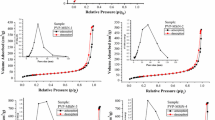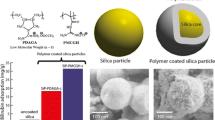Abstract
The organic–inorganic composite materials based on mesoporous silica were synthesized using sol–gel method. The surface area of silicas was modified by bovine serum albumin (BSA) and guanidine polymers: polyacrylate guanidine (PAG) and polymethacrylate guanidine. The mesoporous silicas were characterized by nitrogen adsorption–desorption analysis, Fourier transform infrared spectroscopy, transmission electron microscopy. The obtained materials were used as adsorbents for selective bilirubin removal. It was shown that the structural properties and surface area of modified materials depend on the nature of polymers. Incorporation of polymers in silica gel matrix during sol–gel process leads to the formation of mesoporous structure with high pore diameter and a BET surface area equals to 346 m2/g for SiO2/BSA and 160 m2/g for SiO2/PAG. Analysis of adsorption isotherms showed that modification of silica by BSA and guanidine polymers increases its adsorption ability to bilirubin molecules. According to Langmuir model, the maximum bilirubin adsorption capacity was 1.18 mg/g.







Similar content being viewed by others
References
Brinker J, Scherer W (1990) Sol–gel science: the physics and chemistry of sol–gel processing. Academic Press, Waltham, p 908
Rankin S, Macosko C (1998) Reaction engineering of co-condensing (Methyl) ethoxysilane mixtures: kinetic characterization and modeling. AIChE J 44(5):1141–1156
Rankin S, McCormick A (2000) The kinetics of alkoxysilane sol–gel process. J Chem Eng Sci 55:1955–1967
Menaa B, Menaa F, Aiolfi-Guimaraes C, Sharts O (2010) Silica-based nanoporous sol-gel glasses: from bioencapsulation to protein folding studies. Int J Nanotechnol 7:1–45
Menaa B, Miyagawa Y, Takahashi M, Herrero M, Rives V, Menaa F, Eggers DK (2009) Bioencapsulation of apomyoglobin in nanoporous organosilica sol–gel glasses: influence of the siloxane network on the conformation and stability of a model protein. Biopolymers 91(11):895–906
Zhu X, Brown G, St-Pierre L (1990) Adsorption of bilirubin with polypeptide-coated resins. Biomater Artif Cells Artif Organs 18:75–83
Ahmad N, Arif K, Faisal S, Neyaz M, Tayyab S, Owais M (2006) PLGA-microsphere mediated clearance of bilirubin in temporarily hyperbilirubinemic rats: an alternate strategy for the treatment of experimental jaundice. Biochim Biophys Acta 1760:227–231
Yu Y, He B, Gu H (2000) Adsorption of bilirubin by amine-containing crosslinked chitosan resins. Artif Cells Blood Substit Immobil Biotechnol 28:307–316
Pyanova L (2011) Carbon sorbents in medicine and proteomics. Chem Sustain Dev 19:113–122
Lee K, Wendon J, Lee M, Lim S, Tan K (2002) Predicting the decrease of conjugated bilirubin with extracorporeal albumin dialysis MARS using the predialysis molar ratio of conjugated bilirubin to albumin. Liver Transpl 8:591–603
Tiribelli C, Ostrow J (2005) The molecular basis of bilirubin encephalopathy and toxicity: report of an EASL single topic conference, Trieste, Italy, 1–2 October. J Hepatol 43:156–158
Larry L, Hench Jon K (1990) The sol–gel process. West Chem Rev 90:33–72
Brunauer J, Emmet P, Teller E (1938) Adsorption of gases in multimolecular layers. J Am Chem Soc 60:309–319
Barrett EP, Joyner LG, Halenda P (1951) Determination of pore size distribution by gas adsorption. Ibid 73:373–380
Norde W (2003) In: Malmsten M (ed) Driving forces for protein adsorption at solid surfaces. Biopolymers at interfaces. Marcel Dekker, New York
Hofs B, Brzozowska A, de Keizer A, Norde W, Cohen Stuart MA (2008) Reduction of protein adsorption to a solid surface by a coating composed of polymeric micelles with a glass-like core. J Colloid Interface Sci 325:309–315
Eltekova NA, Eltekov AY (2008) Protein adsorption on silica molecular sieves. J Stud Surf Sci Catal 174:611–614
Lynch I, Dawson K (2008) Protein-nanoparticle interactions. Nano Today 3:40–47
Nakashi K, Sakiyamma T, Imamura K (2001) On the adsorption of proteins on the solid surfaces, a common but very complicated phenomenon. J Biosci Bioeng 91(3):233–244
Sivov NA, Khashirova SY, Malkanduev YuA, Baidaieva MH (2008) Biocide and toxicological properties of synthesized guanidine containing polymer and their structure. Mod Tendencies Org Bioorg Chem 27:310–335
Cheng Z, Yasukawa A, Kandori K, Ishikawa T (1998) FTIR study on incorporation of CO2 into calcium hydroxyapatite. J Chem Soc FaradayTrans 94:1501–1505
Xu Y, Axe L (2005) Synthesis and characterization of iron oxide-coated silica and its effect on metal adsorption. J Colloid Interface Sci 282:11–19
Shengju Wu, Li Fengting, Ran Xu, Wei Shihui, Li Guangtao (2010) Synthesis of thiol-functionalized MCM-41 mesoporous silicas and its application in Cu(II), Pb(II), Ag(I) and Cr(III) removal. J Nanopart Res 12:2111–2124
Huang P, Zhiming L, Hengyao H, Daxiang C (2010) Synthesis and characterization of bovine serum albumin-conjugated copper sulfide nanocomposites. J Nanomater. doi: 10.1155/2010/641545
Sivov N, Khashirova S, Malkanduev Yu, Baidaeva M (2008) Biocide and toxicological properties of synthesized guanidine containing polymer and their structure. Mod Tendencies Org Bioorg Chem 27:310–335
Lee KH, Wendon J, Lee M, Da Costa M, Lim SG, Tan KC (2002) Predicting the decrease of conjugated bilirubin with extracorporeal albumin dialysis MARS using the predialysis molar ratio of conjugated bilirubin to albumin. Liver Transpl 8:591–601
Chen J, Song G, He Y, Yan Q (2007) Spectroscopic analysis of the interaction between bilirubin and bovine serum albumin. Microchim Acta 159:79–85
Acknowledgments
We thank Dr. Khashirova S. Yu., department of macromolecular compounds, the Kabardino-Balkar State University by N.M. Berbekova, for synthesis of guanidine polymers. The work is supported by the Grant of the RFBR (Project No. 12-03-31309).
Author information
Authors and Affiliations
Corresponding author
Rights and permissions
About this article
Cite this article
Timin, A.S., Rumyantsev, E.V. Sol–gel synthesis of mesoporous silicas containing albumin and guanidine polymers and its application to the bilirubin adsorption. J Sol-Gel Sci Technol 67, 297–303 (2013). https://doi.org/10.1007/s10971-013-3079-5
Received:
Accepted:
Published:
Issue Date:
DOI: https://doi.org/10.1007/s10971-013-3079-5




